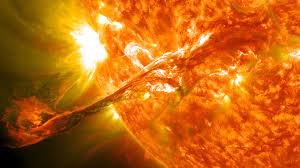
The past year has seen various celestial activity, ranging from April’s solar eclipse to August’s Perseid meteor shower, closing with what is argued to mark the biggest solar event since 2017. A recent solar flare on December 31st has sparked intrigue, taking various social platforms by storm, and prompting scientists to take a closer look at the potential threats it poses. This won’t be the last solar activity Earth sees for some time, however, as the Sun nears its solar maximum in 2025. Although solar flares are a natural occurrence considering the Sun’s behavior, their intensity during solar maximum can introduce challenges for life on Earth. Let’s consider what to expect as the Sun approaches solar maximum, considering the potential impacts it may have on Earth, and explore vital tips on how to remain safe during times of increased solar activity.
Solar Storms and Solar Maximum
As the largest of explosive events within our solar system, a solar flare is classified as an intense emission of plasma from the Sun’s outermost layer. These sudden eruptions travel at the speed of light, reaching Earth in around eight minutes. They interact with the planet’s magnetic field, interrupting power lines, radios, and satellites. Measured according to their x-ray brightness, flares are classified into four categories: A, B, C, M, and X, in order of increasing intensity. The Sun goes through periods that vary in activity, influencing the frequency of solar storms. This is caused by its magnetic activity, which typically follows an eleven year cycle, during which the Sun experiences a solar maximum and solar minimum. Solar maximum marks the phase in which the highest levels of solar activity are observed, with solar minimum being the phase of lowest solar activity. Solar storms and other activity will only grow in number as we near 2025, the year the Sun is predicted to reach solar maximum.
What To Expect During Solar Maximums
Several aspects can be influenced by heightened solar activity, with the majority revolving around technological issues. Geomagnetic storms induced by solar flares could disrupt satellites and interfere with communication systems, introducing additional risks to power grids. Additionally, auroras (also referred to as northern lights), become more visibly enhanced during periods of high solar activity. Radio and aircraft communications may face disruptions, especially those in polar regions. Additionally, this can produce electric currents in power lines, posing risk to various portions of power grids.
Could The Internet Suffer From Solar Storms?
As emerging solar storms heighten in frequency, the topic of an ‘internet apocalypse’ has found itself trending on multiple social platforms. Users describe how impending solar events are to leave Earth without internet access for months on end. Dr. Massimiliano Pastena of the European Space Agency helped to shed light on the situation in a recent discussion we shared. Both solar flares and coronal mass ejections “[emit] particles that will eventually reach and hit the Earth,” Pastena explains. In some cases, they may be “strong enough to cause problems to multiple Earth infrastructure, typically power plants but also domestic electronics and even satellites that orbit the Earth. The magnetic field around the Earth protects us, but sometimes this space storm can hit hard, that’s why scientists continuously monitor the Sun’s activities to predict this fenomena. A lot of agencies rely on those predictions to minimize the effect.” A study at the University of California, Irvine further concludes that a “1.6% to 12% chance exists that an extended disruption to the internet could occur within the next decade due to a solar storm.” Internet failure on such a scale could introduce devastating consequences, causing billions of dollars of losses per day to the global economy. During times of heightened solar activity, it is critical for both industries and individuals to take steps to stay safe and minimize potential disruptions. In the event of an extreme solar event, phone usage should be minimalized to free lines for emergency personnel, aiding their response time. While flawed and exaggerated portrayals of technological collapse are widespread online, the event remains unlikely, although very much possible.
Conclusion
Despite the media frenzy, there is still no definite threat. “Nasa and ESA have satellites monitoring the Sun,” says Dr. Pastena, “and are working on a new efficient alert system to make everyone aware of the arrival of those fenomena so everyone can take the right precautions.” The development of response plans allow this natural phenomenon to be faced with confidence, ensuring the protection of our ways of life.












